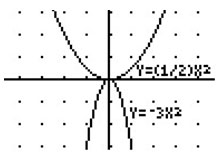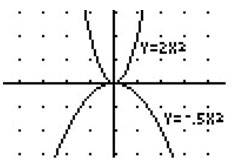
What happens if we change “a” in f(x) = a(x – h)2 + k?
The parameter “a” has two possible effects on the graph:
If “a” is negative (a<0), the parabola reflects across the x-axis and opens down.
If 0<|a|<1, then the parabola is wider than the graph of the parent function. (The parabola has been compressed.)
Determine which of the functions is the widest: y = 1 over 2 1 2 x2 or y = −3x2.
Solution
The coefficient of x2, “a”, determines . . .
For y = 1 over 2 1 2 x2 ⇒ a = 1 over 2 1 2 .
For y = −3x2 ⇒ a = −3.
| 1 over 2 1 2 | = 1 over 2 1 2 and |−3| = 3
Since 1 over 2 1 2 < 3, then y = 1 over 2 1 2 x2 is wider than y = -3x2

Given the parabola f(x) = - 1 over 2 1 2 x2. How would the graph be affected if - 1 over 2 1 2 is changed to 2?
Solution
The coefficient of x2 , “a”, determines . . .
So, “a” is changing from − 1 over 2 1 2 to 2.
Since “a” changes from negative to positive, the graph reflects across the x-axis.
| 1 over 2 1 2 | = 1 over 2 1 2 and |−2| =2. Since 2 > 1 over 2 1 2 then the graph has stretched vertically and is now narrower.
